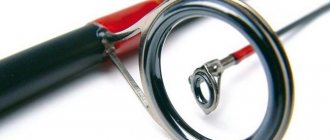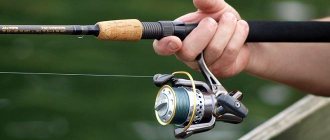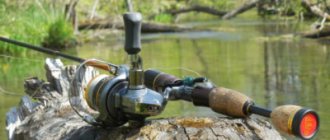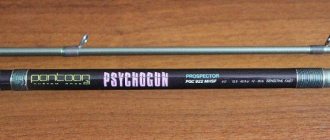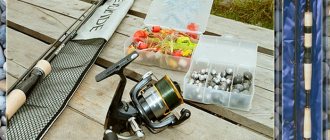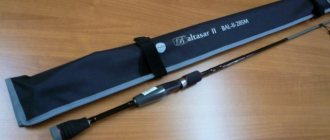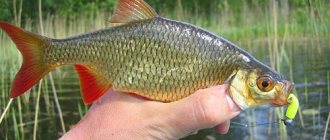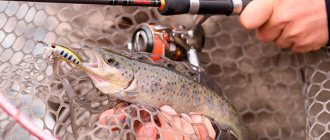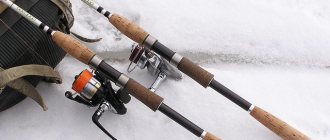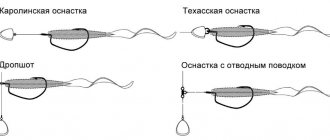The ultralight spinning rod is the lightest and most sensitive among all rods designed for catching predatory fish using spinning tackle.
Due to its small size, thinness, lightness and external similarity, an ultralight class fishing rod is often called a whip . But, it is worth noting that, despite their fragile appearance, such whips are manufactured taking into account the highest requirements, using innovative technologies and the best materials.
By learning how to properly handle such a form, you can achieve impressive results in fishing. It’s not for nothing that many experienced spinners consider ultralight spinning rods to be the most convenient and effective form.
Length of ultralight spinning rod
An ultralight spinning rod that is correctly chosen in terms of length is not only and not so much about good casting, but about the convenience of bait animation.
Please note that I do not write “long cast”! It has been proven more than once that the length of a spinning rod and long-distance casting are, although these phenomena are interconnected, not nearly as strong as it seems at first glance. Both the structure of the spinning rod and its accessories (“body kit”) have a strong influence, which will be discussed a little later. Sometimes we have to sacrifice something: either casting range, or ease of bait control, or reliability of landing fish. Ideally, of course, it’s good when all three of the above points come together in your favorite spinning rod. But this doesn't happen often.
Let me remind you that traditionally the lengths of spinning rods are given in feet (30.48 cm) and inches (2.54 cm) (photo 1 - length 6 feet 6 inches), but products intended for the European market are mostly designated in the metric system ( photo 2 – length 1.98 m, or the same 6 feet 6 inches). Today, manufacturers of ultralight spinning rods usually focus on lengths from 5 feet (152 cm) to 7 feet (213 cm). Ultralight spinning rods shorter than 152 cm are rare. And longer than 213 cm is also not a frequent occurrence: the whole point is that after approximately 213 cm - if the spinning rod has a real test in the upper limit, say, 4 g - the spinning rod turns into a noodle-like unit, which only true fans of such can work with “pasta” (believe me, there are such ones). And, as a rule, such spinning rods are designed for a certain type of bait - for example, small oscillating spoons. If the ultralight spinning rod is quite hard, then most likely the test is underestimated - and in reality it is more than the stated 4 g. And yet, for fans of exercises with longer spinning rods, I will say that since progress does not stand still, I think we can soon expect such spinning rods that will easily fit into the test boundaries of ultralight, but at the same time will be significantly longer than usual.
Another important point is the individual characteristics of the fisherman himself. I have several friends who, depending on spinning rod tests, prefer certain rod lengths. Yes Yes exactly. And they divide tests for themselves in relation to lengths approximately as follows:
test up to 3.5 g (1/8 oz) – length from 5 feet 6 inches (168 cm) to 6 feet (183 cm);
test up to 4 - 4.5 g (1/7oz) - length from 6 feet (183 cm) to 6 feet 6 inches (198 cm);
test up to 5 grams (3/16 oz) – length from 6 feet 6 inches (198 cm) to 7 feet (213 cm).
Occasionally there are spinning rods up to 7 feet 6 inches (229 cm) - taking into account the real test of 5 g.
Agree, it’s quite an interesting approach, and it’s not alien to me personally.
It should be added that this division is of a generalized nature - and you should not urgently look for an ultralight spinning rod exactly 183 cm and with a dough of up to 3.5 g. When choosing the length of a spinning rod, you need to take into account not only the baits used and the methods of “revitalizing” them, but also the conditions of their use. There are no universal spinning rods. With some baits the fishing comfort will certainly be higher than with others. That is, the angler must understand what he wants to achieve from the bait. It is worth remembering that for certain types of fishing artificial baits, the length of the ultralight spinning rod plays a significant role. And if the length of the spinning rod is unlikely to have a significant impact on the work of the spinner, then with a wobbler everything is far from so simple. Sometimes, using only a short spinning rod, a fisherman is able to create such an appetizing “game” for his bait that the fish will accept it very favorably. An important point here is the structure of the spinning rod, which will not be discussed for long. Personally, I consider comfortable lengths for an ultralight spinning rod to be from 6 feet (183 cm) to 7 feet 4 inches (223 cm).
There are fishing conditions when choosing a length is quite difficult. For example, there are banks of a small river heavily overgrown with bushes. By and large, the best option is to go into the water in waders and move up or down the river, fishing for interesting areas along the way. But if the depth of such a river does not allow you to wade along its banks, what can you do? It seems that a “shore” fishing option suggests itself with a short spinning rod, which allows you not to catch the branches of bushes or trees with the bait when casting. On the other hand, due to the fact that approaching the water is extremely difficult, and the bait needs to be retrieved somehow, the option of fishing with a long spinning rod arises, which makes it possible to retrieve it at least along the shore against the current. Once, I don’t remember where exactly, I read that it costs nothing to squeeze a long spinning rod between the branches of a bush and float the same wobbler downstream. Nothing was said there about resolving the issue of catching fish. Apparently, they left the fisherman himself to puzzle over this task... And the third option is not to fish in such places at all. In general, as you can see, the angler is guaranteed a creative approach!
Here we come close to such a characteristic as the structure of an ultralight spinning rod.
What is ultralight spinning rod
Ultralight spinning rods are lightweight rods that can be used to catch medium-sized fish using miniature sensitive baits. This fishing gear is mainly intended for catching predators (perch, pike, chub) using light wobblers and spoons. But often it is possible to catch peaceful representatives of the ichthyofauna using delicate tackle.
The main component of the gear for ultra-light fishing is the rod . The selected tool must ensure high-quality and accurate casting of baits to a specific distance, as well as effective retrieving and fishing of prey caught on the hook. When you get acquainted with a light-class spinning rod, you get the impression of a fragile and impractical rod. But this is not an entirely correct judgment; such tools are made from modern materials and using new technologies that provide them with a sufficient level of strength and ease of use. They are able to withstand a load of 5–6 kg.
Thanks to the excellent performance of a spinning rod with mini-baits, you can hunt predators in overgrown bodies of water. Because of their delicacy, lightweight baits most often attract the attention of the fishing target and provoke them to capture, which explains the high catchability of light spinning rods.
Build an ultralight spinning rod
So, regarding the problem of casting range, many first of all pay attention to the length of the spinning rod, but completely lose sight of a very important, if not the most important characteristic of the spinning rod - the structure of the blank. It “follows” not only from the geometry of the form, but also from the modularity of the material. Each of these mentioned components is ready to have a significant impact not only on casting distance, all other things being equal, but also on the control of your bait. You must always remember about the comfort of controlling the bait. And finally, let’s add a “body kit” here in the form of guide rings, a reel seat, etc. The dynamics of the blank can also affect the casting comfort. In general, everything is not as simple as it seems at first glance...
So, the structure of the spinning rod is one of the parameters of the form, laid down by the manufacturer at the design stage. In general, many people mean different things by action, but it would be more correct if we understand the term “action” of a spinning rod as the bending of a certain part of the blank under a static load, i.e. This is the bending of a spinning rod under the influence of a load of a certain mass. As a rule, to determine this parameter, three or four times the upper limit of the test specified by the manufacturer is used.
The structure of the spinning rod, maintained directly by the manufacturer, cannot be changed in any way, no matter what we do. For this matter is constant and cannot be changed in principle.
Spinning rods for Ultralight - despite all their seemingly “toy-like” appearance - like all other spinning rods, have several classifications according to their static structure. In general, in the spinning world the following classification is accepted, where FAST is a hard spinning rod with a pronounced work of the upper third of the blank. Then come MODERATE spinning rods, where about half of the blank works. And it all ends with spinning rods with a SLOW (slow) action, where the entire form is loaded. This is the basis, so to speak.
There are also spinning rods with EXTRAFAST action, where the upper quarter of the blank works. And MODFAST is an intermediate link between MODERATE and FAST. An interesting point: for Asian manufacturers, MODERATE is also displayed in the specification as REGULAR.
It should be especially noted that in spinning rods for ultralight fishing, if the manufacturer has specified a test close to the real one, we will never see very hard, familiar “fast” spinning rods. It would be more accurate to say that FAST, if present in our spinning rods, has little in common with what we are used to seeing in other, less delicate models. Ultralight is characterized rather by MODFAST, MODERATE (REGULAR) and SLOW.
Now let's talk about the dynamics of ultralight spinning rods. To explain it quite simply, this is the work of the form directly during operation. And it’s precisely the dynamics of the spinning rod that can be changed. The dynamics of absolutely any blank is seriously influenced by all the accessories: here are the rings, the threads that attach these rings to the blank, the reel seat, the material of the handle (cork, EVA, etc.), and even the varnish that covers the blank. The dynamics can be seriously improved if you “hang” as little as possible on the form of unnecessary details, sometimes serving a purely decorative function.
The angler’s desire to control both the fish and the bait is understandable, but sometimes it is achieved only at the expense of casting range. Some people, on the contrary, consider casting range to be more important. Know that spinning rods with a slower action throw further, but lose accuracy. And vice versa. Although these statements are far from an axiom, there are also strictly opposite examples. And yet much, very much depends on the manufacturer. It depends on what technologies he uses, how he knows how to work with materials, what geometry the blank is, what its length is, the structure, how the spinning rod is equipped with fittings. All components are important, the entire set of parameters - there are no trifles here. And only when all the nuances are given equal attention, only then can the end result be a truly magnificent spinning rod that works real miracles while fishing and gives joy to its owner.
Reels for ultralight
When giving preference to one model or another, you need to take into account its weight in order to achieve optimal balance of the gear. So, if the light spinning rod is over 2 m, then a light-weight reel will not work here; you will have to choose heavier versions - with a weight of 200 g. In addition, you should pay attention to such parameters as:
- Spool size. Since ultra-light spinning rods use thin lines, delicate baits, and the size of prey rarely exceeds 1-1.5 kg, it is optimal to choose a product with a size of 1000–2500. Reels from Daiwa and Shimano have proven themselves the best. For ultralight, a 2000 size spinning reel is perfect, equipped with a low-profile spool oriented towards thin cords. If you plan to hunt a toothy beast, chub, asp, then it is more rational to choose a “meat grinder” 2500, which can withstand the resistance of the treasured trophy.
- Quality of laying of fishing thread. A reel for a lightweight rod should ideally place a small-diameter thread on the spool, there should be no hints of dips, there should be no humps. If such errors are observed, this will provoke not only the loss of loops, but also the appearance of beards and damage to the cord. A high-quality reel for ultralight is characterized by a smooth operation; during its operation, extraneous sounds and gaps are eliminated.
- Friction brake. Thanks to the sensitive friction mechanism, which is very fine in adjustment and operation, it is possible to effectively dampen the jerks of the prey during the fishing process, letting the cord loose and preventing it from being damaged. It also prevents the thread from breaking if it gets caught on aquatic vegetation and other obstacles at the bottom of the reservoir. As practice shows: the more expensive the product, the higher the degree of sensitivity of its clutch.
- Number of installed bearings. The optimal solution is 12 bearings on an ultralight reel.
In order for fishing to be as productive as possible, you should not choose models made of plastic; it is not advisable to save money here. It is better to purchase a high-quality reel from a trusted manufacturer.
Type of connection of the knees of the ultralight spinning rod: Spigot or put-over?
The long-standing debate about which type of knee connection for an ultralight spinning rod is more reliable and practical is unlikely to ever find a single correct answer. But in the course of frequent conversations and expressed opinions from practicing fishermen, it was possible to find out that, by and large, it does not matter what kind of connection the manufacturer uses - be it put-over (photo 3 a, b) or spigot (photo 4 a, b). What is important here is a well-designed junction of the spinning rod’s knees. As one of my friends said: “The joint should not be a foreign, rigid element.”
Almost all Western manufacturers of spinning rods use put-over. But in the East, spigot is highly respected. Especially in the ultra-light series of rods. Making a good spigot is no easy task. It's all about the accuracy of manufacturing and the quality of fit of the parts. “Excesses on the ground” happen both here and there. In my opinion, if the joint is tight enough, there are no extraneous knocks, and the upper elbow does not fly into the pond from time to time, then it will be a spigot or a put-over - it doesn’t matter. The reliability of the connection and the participation of the docking point in the operation of the entire form without compromising its characteristics is what is most important here.
Rarely, you can still find a connection when the upper part “sits” on the lower part (photo 5). Although previously such a connection was quite common. Today it has almost completely lost its position, but it is impossible to say that it is not used at all.
Ultralight spinning rod design
First, let's turn to the Internet and see what design is in the mouths of professionals. So, “design is a creative method, process and result of the artistic and technical design of industrial products, their complexes and systems, aimed at achieving the most complete compliance of the created objects and the environment as a whole with the capabilities and needs of man - both utilitarian and aesthetic” .
But this definition was proposed by the famous designer Thomas Maldonado: “Design is a creative activity whose purpose is to determine the formal qualities of industrial products. These qualities include the external features of the product, but mainly those structural and functional relationships that turn the product into a single whole - both from the point of view of the consumer and from the point of view of the manufacturer."
To be honest, I am somewhat doubtful whether it is worth taking upon myself the courage to publicly express my point of view on such a controversial issue? For, completely unwillingly, I might even offend some fishermen who have in their possession things that I suddenly call the height of bad taste. We just may like completely opposite things. Therefore, in this part I will try to be as “politically correct” as possible. And at the same time I will try to convey some of my thoughts.
So, we have two camps of opposites. One in the West, the other in the East. I mean American and Asian manufacturers of spinning rods.
Let's take “West” first. Spinning classics are, of course, good! But it personally pains me to see high-quality gear literally “killed” by poor design. This is just some kind of mockery of the fisherman. Or take, for example, the almost manic love of Americans to install guide rings of increased diameter on the blanks of spinning rods. Not only do they not have the best effect on the blank with their mass, but they also visually overload the spinning rod.
Yes, we all know that American manufacturers tend to pay more attention to the performance characteristics of spinning rods, and only then to everything else. But in our case, functionality is precisely those very performance characteristics in which the ease of use of the product is not given the last place. After all, it is common for a consumer to form the very first impression based on external, eye contact. Then tactile sensations come into play, i.e. ease of holding the spinning rod in your hand. I know from my own example how distracting and what discomfort an inconvenient and ill-conceived “holder” made to please the so-called “classical Spartan style” causes. Despite the fact that the spinning rod is simply magnificent in its characteristics. I don’t think it will be a revelation to anyone that selling a product that combines the opportunity to attract the buyer’s attention, but at the same time is also distinguished by convenience and functionality, is much simpler and more effective. So why shouldn’t American manufacturers combine these components of a worthy product into a single whole? Mystery. Although, as the classics used to say, “everything flows, everything changes.” The well-known American company for the production of spinning rods, St. Croix, is soon entering the market with a new Legend Tournament model, where, undoubtedly, more attention was paid to the design of the spinning rod (photo 6). Whether it will be successful or not – we will get the answer in the near future. But the fact that the matter seems to have moved from a dead point is clear. Down and Out trouble started?
Now let's talk about the "East". Here everything is exactly the opposite! If in the “West,” as they say, “there’s nothing to lay your eyes on,” then in the “East” sometimes they’ll do such a lot on a spinning rod that it’s more likely not a spinning tool, but some kind of golden scepter of an Egyptian pharaoh, no less! Here you will find gold and silver threads, a futuristic holder, metal inserts, and varnishes of all colors of the rainbow - it’s hard to describe everything. Even though there are not enough precious stones. Or at least rhinestones from Swarovski.
But the final quality of the spinning rod may not be up to par. Often all sorts of “trinkets” are used to hide the manufacturer’s mistakes. Sometimes they even cause the breakdown of a completely decent spinning rod. Plus, don’t forget that all these “bad excesses” have a serious mass, which does not have the best effect on the dynamics of the spinning rod, greatly affecting the overall balance of the tackle. But we are always trying to fight every extra gram. We are trying to reduce the total weight of the gear as much as possible, but here we have such a “body kit”!
But this, of course, is an extreme. If we take a serious Asian manufacturer, then he will undoubtedly try to add some “oriental raisins” to the exterior decoration. But as for all the unknown “products” that have already set their teeth on edge, mostly Chinese semi-legal productions, then be on your guard! The main thing there is to attract the buyer’s attention. Few people remember the final purpose of the product and its quality, if they remember it at all.
For some reason I can't get architecture out of my head all the time. The eye should “catch” to the details of the facade. Remember the old, pre-revolutionary merchant houses. What about country estates? Remember Stalin's skyscrapers. There are so many small details and unexpected solutions. You look and look, each time discovering something new and interesting. Perhaps, on the one hand, it is not very correct to compare spinning rods and architecture, but on the other, making a spinning rod is also a kind of construction, only expressed in other forms and materials. And the “façade” should attract attention, but not “shout.”
To take a little break from sad thoughts, I suggest you take a look at the very interesting fastening of rings to the spinning blank with silk, which is practiced by some Japanese manufacturers. When covering a silk winding with varnish, a transparent effect appears - as if there was no top layer of thread at all and the throughput rings were simply filled with varnish on top (photo 7). You may or may not like it, but it’s quite original, you’ll agree.
Unfortunately, any mass production cannot take into account all the preferences of a particular fisherman. His individual characteristics. Of course, everything should be in moderation. And catching that fine line is extremely difficult. On the other hand, we are all human and have our own, sometimes very original and even controversial, views on some aspects of exterior decoration. But there are interesting things where, in my opinion, both the external features of the product and functionality are combined (photo 8). However, I do not insist in any way... but when choosing, I will still prefer “curvy Asian women.”
Rating of the best models of ultralight spinning rods
The top 10 ultralight spinning rods will help you decide on the choice of a lightweight tool.
Banax Ultra
The high popularity of South Korean instruments is due to their budget, versatility, decent performance characteristics and a lot of positive reviews. The model with a test load of 1–8 g is especially in demand. Even a novice angler can handle it. This spinning rod is distinguished by its ability to work with a variety of baits and with any fishing method.
Banax Ultra blanks are made of high-modulus graphite and equipped with high-quality fittings: a reliable tulip and guide rings, a functional reel seat. Due to the dual-frequency design, such poles do not create difficulties during transportation.
Norstream Area

Spinning rods were specially designed for fishing with light and ultra-light baits. In total, the line includes three versions, each designed for specific fishing conditions and bait. A universal option is a rod with a test load of up to 10 g.
The models are made of high-modulus carbon fiber using ULR technology, which combines low rod weight and sufficient rigidity with a high level of sensitivity. Single-support rings equipped with titanium frames and silicon carbide inserts from the Japanese manufacturer Fuji also contribute to the lighter weight of the tool. The spaced handle made of EVA synthetic material also attracts attention, which ensures the balance of the gear.
Tenryu Lunakia
This is the best ultralight spinning rod created specifically for rock fishing - Japanese sea fishing. In our realities, the rod has proven itself to be excellent when working with miniature wobblers, micro-oscillators and spinners. This series is distinguished by its elegant white blank, lightweight guides, anti-twist tulip, as well as a spaced neoprene handle and a reliable screw-type reel seat.
Norstream Micromania
This is a series of inexpensive ultra-light fishing rods designed for fishing with microjigs, miniature wobblers and spinners (weight up to 5 g). All versions have a sensitive carbon fiber tip, which makes it possible not only to control bites, but also to create aggressive animation of the bait. The handle is made of cork and EVA synthetic material. The rings are equipped with SiC inserts. Thanks to the great power of the blank, it is possible to catch relatively large fish without serious difficulties.
Pontoon 21 High Point Stylo
This series of lightweight High Point tools is especially appreciated by professionals who use them to catch trout in competitions. Rods are made from graphite. The tool is equipped with Fuji KR series guide rings. The spaced ergonomic handle is made of cork and porous EVA material. Ultralight spinning rods are distinguished by their build quality, performance characteristics and original design.
Megabass Shore Light Game
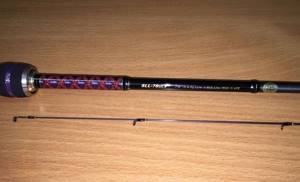
The series of rockfish spinning rods released in 2021 has already managed to win the trust of both outdoor enthusiasts and professionals. It is designed for microjig fishing. With the help of such rods you can work with elegant baits weighing from 0.5 g. Anglers are especially pleased with the flexibility of the tools and a sufficient margin of safety. The build quality does not let us down either, which, as before, is at its best.
The series includes 4 versions, differing both in length and test value. An “S” on a rod indicates a hollow tip, while a “T” indicates a solid tip. Such spinning rods make it possible to calmly control the behavior of prey and fish it out.
Norstream Provokator
This line is distinguished by its lightness and excellent balance. Rods with a high degree of sensitivity and versatility in use. The tools, thanks to the reinforcement with additional braiding (in the butt part), allow you to fight with a serious opponent. The raw materials used for the manufacture of forms contain a minimal amount of binding resins.
Spinning rods are equipped with lightweight Fuji guide rings with titanium frames, which are used in elite models. The updated tools feature a Fuji TVS reel seat, which is lightweight. Four rods from this line are aimed at fishing with twitch, jig and surface lures.
GAD Gancho
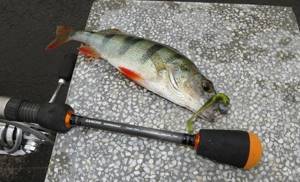
This series features a variety of models, most of which are designed to work with ultra-light lures. Moderately fast tools allow you to make jerks and play the necessary game without much difficulty. Made from medium-modulus materials, the rods are distinguished by increased strength and a high degree of sensitivity. The length of the instruments varies from 183 to 213 cm.
Daiko Featherweight
Spinning rods have sufficient balance and fast action. The majority of the tools in the line are universally designed and can be confidently used with ultra-light lures. Models marked “T” are designed for twitching small minnows.
Palms Egeria Area
This specialized ultralight series is designed for catching pond trout. Graphite material was used to make the blank. The rods are equipped with Fuji KR anti-twist guides, the tulip is made in a titanium frame with a Torzite insert. The handle is comfortable to use, made of cork material. Tools in this series have sufficient casting range and accuracy. In addition, spinning rods attract attention with their lightness, reliability and deterrent potential.
Fishing with fine gear is truly an unforgettable experience that requires both skill and patience from the angler. To ensure a catch, you need to know all the features of ultralight spinning rods.
Ultralight spinning rod accessories
When assembling, and even more so when purchasing a ready-made spinning rod, you need to pay special attention to almost all the details of the fittings and decor! After all, as we already found out earlier, even the way the guide rings are wound on can significantly change the dynamics of the spinning rod. Let me explain with an example. Some Asian manufacturers, in order to highlight the color embedded in the threads, a special shade or shine, that is, a design for, wind special Lurex into the places where the rings will be installed, then attach a ring with threads on top of the Lurex and patch it (photo 9). So, if such a procedure took place with a spinning rod that did not belong to the ultralight class, then most likely you would not notice any difference in the final dynamics. The impact of the applied excess mass is too small. But in the case of an ultralight spinning rod, given its low mass, such a procedure can greatly affect the final dynamics. This is especially noticeable if the spinning rods have a REGULAR or SLOW action. Remember: no matter how little rings, lurex and threads weigh, no matter how little varnish, cork, etc. weigh. – this is still a certain mass attached to the form. Taking into account the fact that with this method of installing the rings, varnishing the windings should occur three times (instead of twice, without lurex), and “naked” ultralight forms can weigh only 20 grams (and sometimes less), then such a “load” can have a serious impact on the form - simply put, the form may be overloaded. However, manufacturers sometimes use a trick and save time and coat the windings at a time. Which is generally not good...
Scared? Don't be afraid, it's not all that scary, this is just an example. Just imagine how much the entire “Pokemon decoration” can weigh and how it can change the spinning rod beyond recognition.
So let's take a quick look:
pass rings;
handle material;
types of reel seats.
Ultralight tackle
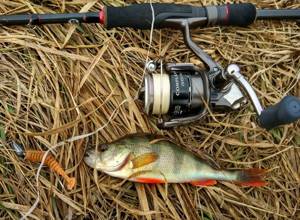
To fish with ultra-light lures, you must have the appropriate spinning kit, which allows you to cast weightless spinners and wobblers, animate them, with full control over the retrieve. Without properly selected and balanced gear, there is nothing to do when fishing with ultralight baits.
Today's fishing market offers ultralight gear in a wide range. There are decent models of rods, lines and reels in any price category. Therefore, buying a spinning rod for ultralight and equipping it will not be difficult even for a beginner ultralight.
Ultralight spinning rod for ultralight
The issue of choosing a spinning rod for ultralight must be approached responsibly. A lot depends on a well-chosen tool. There are relatively universal spinning rods suitable for different baits. They are usually in demand among novice anglers or those who fish with ultralight from time to time. Such spinners need one “stick” that will allow them to fish with micro-oscillators, “rubber”, and various wobblers.
Advanced and professional fishermen approach the choice of fishing rod more thoroughly. Often, everyone has several highly specialized spinning rods, focused on solving specific problems.
For example, professionals must have a rod for microjigging or a rod for trout fishing on paid ponds. Fans of chub hunting also buy a “rod” with special capabilities that allow them to catch this strong and sharp representative of the ichthyofauna with ultra-light baits.
The length of spinning rods for ultralight can be from 1.60 to 2.70 meters . “Shorty ones” are good for fishing in limited conditions or in short distances. Tall fishing rods are used on medium and large rivers, where the casting distance of an ultra-light bait often plays a decisive role. The universal rod length for UL is considered to be 2.10–2.20 meters.
The test of an ultralight rod can be different. The lightest “sticks” are designed for baits from 0 to 3–4 grams. The bulk of spinning rods for UL have a test for baits up to 7 grams. Some models that are used for chub fishing can be used with baits up to 8–9 grams. They can also, with a stretch, be classified as ultra-lightweight.
The best spinning rods for ultralight are made by Japanese manufacturers. Many of them performed excellently in our conditions. In the mid-price segment, Korean and European brands compete with the “Japanese”. The budget category is represented mainly by spinning rods made in China.
Ultralight spinning test 0.5-5 grams
Inexpensive ultralight spinning rod with working dough 0.5-5 g. allows you to fish with the entire range of microjig baits, Texas, Carolina, and allotment. Plus, you can use it to catch light spinners.
Reel for ultralight
An ultralight spinning reel is no less important element of the gear than the fishing rod. It must meet the following requirements:
– possibility of use with thin cords and fishing lines; – even laying of the thread on the bobbin without humps or dips; – smooth velvet ride; – reliable sensitive clutch; – light weight.
The optimal coil size for ultralight is 2000 . It is better to choose reels with a small-profile spool. They are specifically designed for thin lines, do not require a large amount of backing, allow you to cast bait further and tangle the thread less.
Ultralight uses high-speed reels. Many models have a gear ratio of 1:5.2 and higher. Powerless inertia is not needed here. Particular attention should be paid to the quality of the friction clutch. His work should not cause any complaints, otherwise the loss of bait and trophy while fishing is inevitable.
Read more about choosing a coil for ultralight
fishing line
In order to successfully fish with ultra-light baits, you need a thin monofilament line or braided cord. Its diameter must be sufficient to throw a spoon or wobbler at a given distance. The optimal diameter of the UL thread is from 0.10 to 0.14 mm.
In microjig fishing, twitch fishing, and chub hunting, there is no alternative to braided fishing line. Tensile monofilament will not be able to meet all the requirements set by these types of fishing. When using spinners, micro-oscillators and, in some situations, wobblers, nylon can be used. Here, its qualities, on the contrary, are needed and provide the fisherman with certain advantages.
In ultralight you can't do without leashes. In 9 out of 10 cases, fluorocarbon line is used. It is practically invisible in the water and does not scare away fish. This quality is extremely important when hunting cautious underwater inhabitants, such as trout, ide, asp or chub. In addition, fluorocarbon has increased abrasion resistance, allowing you to fish for pike or fish on shell rocks and snags without fear for the integrity of the equipment.
Passing rings
A modern ultralight spinning rod is practically unthinkable without guide rings in titanium frames from the Japanese concern Fuji. Visually, they cannot be confused with any others (photo 10). The rings are so light that with their mass they have a minimal impact on the spinning rod blank, changing its dynamics little. If such rings are on a spinning rod, you should take a closer look at it. Good guides can serve as a kind of indicator of the quality of the spinning rod as a whole. But such access rings are also a tribute to a certain fashion - and little-known manufacturers, in order to attract attention to their mediocre product, do not hesitate to place them wherever possible and impossible. I saw them several times even on expensive spinning rods from a famous Japanese brand, where I observed an ounce (28 grams) at the upper limit of the test! Honestly, it’s an absolutely crazy decision!
But we got a little distracted. If you suddenly don’t find ultra-light guides on your ultralight spinning rod, don’t immediately put it aside. In cases where the form needs to be loaded in a certain way - for example, in the upper part - the manufacturer can choose to install throughput rings of greater mass while maintaining the same dimensions. It’s just that the rings are installed not in titanium, but in steel frames. Accordingly, the applied mass to the spinning blank changes upward. It all depends on what the manufacturer wanted to achieve in a particular spinning rod model. Sometimes it’s enough just to change the last ring (i.e. “tulip”) from a titanium frame to a steel one - and the dynamics of the blank will noticeably change.
Spinning rod handle material
Everything is much simpler here. As a rule, the handles use cork (photo 11), less often - synthetics, the so-called EVA (photo 12). EVA was previously used in spinning rods intended for sea fishing, but now they do not hesitate to use it in freshwater series. There are also combined handles, where EVA and cork can exist in a single composition (photo 13). EVA has a certain advantage - that as a material for designer fantasies, it is produced in different colors. And it is well processed mechanically. Another question is that even the most wonderful EVA is heavier than cork. Remember the fight for grams? Keep this in mind.
Types of reel seats
The operating principle of all reel seats that we see on ultralight spinning rods (except for one - the so-called “French”) is the same and is based on attaching the reel to the spinning rod using a threaded connection. Reel seats are considered very convenient, where one of the handle elements is involved in securing the reel (photo 14 a, b). Really convenient, beautiful, reliable. Mainly Asian manufacturers are famous for such “holders”. Western people prefer the “classics”, where the coil is fastened using an ordinary screw nut (photo 15). And, I want to say, he doesn’t complain much either.
The “French” holder is two non-threaded rings that move freely along the handle (photo 16). This reel seat is the lightest and at one time was often installed on ultralight spinning rods. But it has one serious drawback: at a crucial moment, the reel can simply fall out of such a reel seat. Over time, especially if the spinning rod is used frequently, such a connection becomes unreliable. The moving rings and plug in the place where the coil is often installed seem to break, which leads to such consequences. There is an exit. Immediately after installation, additionally secure the rings after the coil with adhesive tape or tape. True, the appearance suffers from this, and the adhesive also leaves dirty marks on the cork. Or, as someone advised, just moisten the plug in the place where the coil is installed with water. However, as it turned out, this does not help much. The “French”, made on a spinning rod by a good experienced craftsman, is free from the above disadvantages. Because the master very carefully adjusts all the details. On serial spinning rods, it is hardly possible to completely fine-tune the “French”. But the “Frenchman” still has a plus, despite all its disadvantages. The only one. This is an opportunity to install the reel in any convenient place on the handle - to find the best overall balance. Although it is unlikely that this plus can outweigh the minuses. We need to look locally...
Light spinning rods (lures from 7 to 14 g)
Spinning fishing with minnow wobblers
— Fishing with classic and popular minnow wobblers (ZipBaits Rigge 70F and 70S, Megabass X-70, Cultiva Rip'n Minnow Deep 70SP) in cramped conditions of a small river or fishing in the flow of deeper rivers implies a decent reserve of power for power fishing.
Among the “Americans” my best spinning rod is Lamiglas Certified PRO 6'6'' 10.5–21 g, and among the Japanese - Major Craft Day's 7'3'' 5–14 g.
— Banax Blade 8'3'' 4–18 gr. I use it for long-distance fishing. Either - when a predator does not allow the fisherman to get close (for example, fishing from a boat in the calm), or during coastal fishing, when the choice falls on one spinning rod, which can be used to fish in completely different ways.
—St. Croix Avid IPC 7'6''4–14 g. A legendary model that continues to reliably hold its place among the leaders, especially after its update - IPC (Integrated Poly Curve). A very popular and versatile spinning rod model, well suited for both aggressive twitching and smoother retrieving with deceleration and acceleration. It was once the main spinning rod of Alexey Shanin for fishing with wobblers and jigs.
— Talon TX 7'6'' 5–17 gr. My specialized spinning rod is for fishing with wobblers at a “slow pace”, usually with a “stop and go” retrieve. I discovered the very high effectiveness of this method with numerous options for selecting catchable wiring for such well-known wobblers as Tiny Magallon and Magallon. And only the method of slow, unhurried animation of such compounds has brought and continues to bring stable results where many other wobblers catch an order of magnitude less.
— Black Hole Bassmania 7' 4.5–16 g. Few spinning rods can compare with it when it comes to “hard”, power twitching of minnow wobblers. We will not go into the details of when and under what conditions this style is needed, I will only say that in certain conditions this spinning rod is indispensable. So, for these purposes I choose Black Hole Bassmania.
Spinning fishing with walkers and poppers
— Banax Blade 8'3'' 4–18 gr. Just like with minnows, all the laws of the genre are preserved in this section. If you need to cast far, if a predator won’t let you get close, and if you want to fish with one of the lightest and “slender” spinning rods in its class, then this will be the Banax Blade.
—St. Croix Avid IPC 7'6'' 4–14 g. A universal spinning rod that is also well suited for surface baits.
— Talon TX 7'6'' 5–17 gr. For Russian predators, it is “important” that the walker moves regularly from side to side when retrieved, like the pendulum of a clock. And the popper did not fly out of the water when jerking, but steadily “slurped.” If something doesn’t work out for you with the wiring or it works, but you don’t like it or it’s simply uncomfortable, start re-mastering this class of lures, only with the Talon TX. I use it when a predator pays very close attention to the quality of the retrieve, and there are ripples in the water, which greatly interfere with fishing with surface baits. Fishing with unhooked baits in the grass
— Lamiglas Certified PRO 6'6'' 10.5–21 gr. Fishing at close range or in cramped conditions. In this option, I choose the shortest and lightest spinning rods with the necessary margin of safety. Because of its power, it reliably cuts through predators, and its lightness gives overall comfort to fishing. As a rule, I fish more often with this spinning rod from the shore.
— Black Hole Bassmania 7' 4.5–16 g. My main spinning rod for catching pike in the grass. Light, sensitive, with a colossal reserve of power. Just like many other spinning rods mentioned in this article, many competitions have been won with the help of Bassmania, the most significant of which is the World Championship in catching predators from boats, which took place in the Saratov region.
— CD Rods Blue Rapid 8'6'' 10–35 gr. It also happens that when fishing in the grass (with light spoons, rubber without weight), the pike does not let you get close. Or he attacks, but there are many “left” exits and misses. And sometimes, only at a long distance the pike violently attacks the bait, reliably being detected.
How to be in this case? Take a more powerful spinning rod, a thicker fishing line and a heavier spinner. And we need the length of the spinning rod not to cast far away, but to prevent the trophy from diving under the grass carpet after a bite in the distance, thereby greatly complicating your subsequent fishing. Of course, this is if it continues... This is one of the lightest and toughest spinning rods with such parameters.
Fishing with a spinning rod on a retractable leash and Carolina
— Major Craft Day's 7'3'' 5–14 gr. Fashionable and modern spinning rod. In general, I think this kind of “peg-shaped” system is the future. If we move even a little away from the standard fishing conditions, we will find that this is the system we need, it is the most justified.
When fishing from a boat with a retractable leash, when fishing in the current with both jigs and wobblers...
In a word, rigidity and lightness are now beginning to be valued more and more. In our case (retractable leash, Carolina) it is possible to perform precise wiring and make really sharp jerks with the spinning rod, when necessary, only with such a spinning rod. And even the side wind is not a strong obstacle here. Fishing from a boat with a retractable leash is his strong point.
— Banax Blade 8'3'' 4–18 gr. At the moment, my main spinning rod is for the shore branch leash. The Banax Blade 8'3'' spinning rod is good for everyone. It is light, sensitive and has a very fast action.
Even at the maximum casting distance, it allows you to confidently perform jerks of the required strength and amplitude, which has already been confirmed by two victories at the “Winter Predator”. Then I had a prototype of this spinning rod model in my hands.
—St. Croix Avid IPC 9' 7–21 g. As I wrote a year earlier, this spinning rod was and remains my favorite when purposefully catching perch with a retractable leash from the shore. It is necessary when we fish by dragging along the bottom with slight swaying of the spinning rod and very light twitching. But once upon a time, back in the old version, this was my main spinning rod for shore jig fishing for many seasons...
